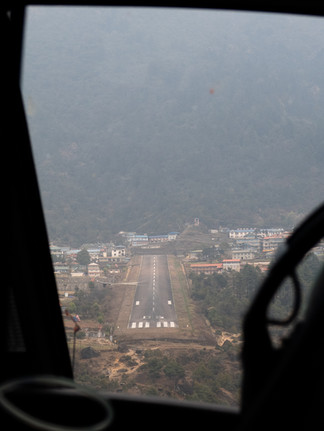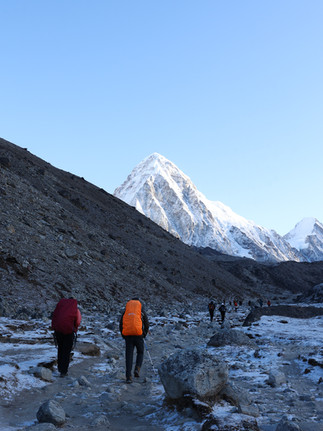Everest Base Camp Trek: Everything You Need to Know
- Megan Potter
- 7 days ago
- 10 min read
The EBC Trek is one of the world’s most famous hikes and Nepal’s most traveled routes, guiding hikers through the Khumbu region’s remote Sherpa villages, suspension bridges, and rugged mountain trails among snow covered peaks, to the foot of the highest peak on Earth. The trail moves through daily life in the Himalayas, where yaks carry supplies and tea houses provide a place to rest along the way to the base of Mount Everest.
Table of Contents
Time of Year

Late September to November: Best for clear visibility post-monsoon season. Daytime temperatures are similar to spring, though nights are slightly cooler. Base Camp is generally quieter during this time, as there are fewer climbing expeditions.
March to May: Best for warmer temperatures and the flowering season, when rhododendrons and alpine flowers are in bloom. There tends to be more afternoon cloud cover in the pre-monsoon season, but good visibility of the peaks in the morning. It’s also the busiest time for trekkers, as many expeditions take place in April and May — you may find yourself staying in the same teahouses as climbers preparing to reach the summit.
This guide is based off an April trek.
Altitude & Acclimatization
If a person were suddenly transported from sea level to the summit of Mount Everest, they would likely pass out and die within minutes.
Everest Base Camp is at 17,598 ft/5,364 m, with several nights spent above 13,000 ft/4,000 m. Most itineraries include two rest days - Namche Bazaaar and Dingboche - to help your body adjust to the high altitudes.
Take Diamox, preferably the ones that work within 30 minutes. These should be provided by your tour guide. Once symptoms of altitude sickness appear, it’s too late to start. Altitude sickness is a very serious issue, and you won’t be able to continue ascending if it occurs. If you do get symptoms, depending on how severe they are, you may have to spend extra days acclimatizing or turn back. To help your body adjust, it’s also important to avoid alcohol during the trek.
Trekking Information
Tour Guides & Porters

Hiring a tour guide isn’t required, but it’s recommended to make the trek easier and safer, and for a more in-depth experience into the region, its culture, and the trail beyond just the route itself. A guide handles all permits and fees, transportation to and from Lukla (and alternatives if the weather isn’t ideal), points out mountains of significance along the way, checks blood oxygen levels each night, and arranges all meals and accommodation.
Hiring porters is a responsible way to help local communities when done correctly. Many porters are from the region and rely on trekking for income. It’s common for locals to start as porters to gain experience of the trails, local villages, and logitics before becoming certified guides. They should carry reasonable loads, and reputable companies ensure fair wages, insurance, and safe working conditions.
Almost everyone in the group hired a porter.
Green Valley Nepal Treks is a highly recommended reputable company based in Kathmandu and they aim at keeping the groups smaller.
Tips: $10-15 a day for the porter and $10-15 a day for the guide.
Itinerary Options
The standard itinerary provided by the tour company is usually followed, but there is flexibility for customization - for example, some in the group combined days 10 and 11 and trekked from Pangboche to Lukla. While this isn’t generally recommended, it can be arranged if the tour guide is able to accommodate the change.
Other tours offered include camping at Everest Base Camp, completing the trek to Base Camp with a helicopter return (11 days), or taking on the longer Three High Passes trek (19 days).
Sherpa vs. sherpa
Sherpa: The ethnic group native to the Everest region, adapted to living at high altitudes and often involved in mountaineering.
sherpa: A job title for someone who carries loads for trekkers or climbers, regardless of ethnicity.
Trash
Everest Base Camp has a history of waste issues due to the high number of trekkers each year, but conditions have improved significantly. Large cleanup expeditions and the Carry Me Back initiative help reduce litter along the trail. Trekkers can pick up a 1 kg bag at designated stations, fill it with trash found on the route, and carry it down. Once in Lukla, the bags are collected and transported to Kathmandu for processing and recycling.
Our group rarely saw trash left on the trail during the trek.
Teahouses

Teahouses along the trek offer very basic accommodations, and amenities like Wi-Fi and charging become limited at higher altitudes. Meals typically include dal bhat (rice with lentil soup and vegetables), momo (dumplings), noodles, fried rice, and soups, with drinks such as coffee and hot tea. Common rooms are heated—by wood or gas at lower elevations, and by yak dung higher up—and typically only during breakfast, dinner, or both. Individual rooms are not heated. Cleanliness can be an issue—most nights you’ll use your sleeping bag with a liner and wrap it around your pillow to avoid direct contact with the bedding.
Preparation
If you're reasonably active, you should be able to manage the trek. While the route isn't constantly steep, each day involves several hours of walking with a mix of uphill, downhill, and flat sections while carrying a backpack. Generally you’ll hike for a few hours in the morning, take a lunch break, and then continue for a few more hours in the afternoon. On acclimatization days, the hikes are shorter— 1–2 hours—allowing you to adjust to the altitude before relaxing for the remainder of the day.
Tips
Bring plenty of socks.
Keep your luggage within the airline's weight limit from Kathmandu - Lukla - 33lbs/15kg per person. This includes the total weight of both the day pack and duffle.
A sleeping bag liner is ESSENTIAL, the longer the better
Pack light rain gear - can often find ponchos and rain jackets at multiple stops along the trail.
Bring protein bars and protein powder and try to avoid eating eggs or meat during the trek.
You don't need thermal water bottle as water will stay cold throughout the day.
At night, put your phone in your sleeping bag to preserve the battery, and base set of clothes inside to keep them warm for the next morning.
Lunch tends to be earlier, around 10 AM to noon, so plan accordingly.
You'll need cash, as banks in Nepal often have low withdrawal limits—take money out before you arrive.
Break in your hiking boots well before using them for the trek.
Packing
Use packing cubes to separate hiking clothes from teahouse clothes.
Clothes
Down Jacket
Windbreaker/Rain Jacket
Fleece
Vest
Light Jacket
Teahouse Sweatshirt
Hiking Pants
Sweatpants
Leggings (2-3)
Long Sleeve Shirts (2)
Short Sleeve (2)
Sports Bra (2)
Merino Wool Socks
Gloves
Hat
Shoes
Hiking Boots
Lodge Sandals
Toiletries
Sunscreen
Wet Wipes
Travel Shampoo & Conditioner
Travel Toothpaste
Handheld Mirror
Tissues
Hand Sanitizer
Misc
Water Filtration Tablets
Wet Wipes
Trash Bag
Toilet Paper
Microfiber Towel
Sleeping Bag Liner
Electrolytes
Sunglasses
Book/Kindle
Snacks: Dry fruit, protein bars, nuts
Blister bandages
Diamox, Imodium, Cold Medicine, Cough Drops
Passport
Day Pouch
Backpack
Tech
Camera & Backup Batteries
Phone Charger
Power Bank
Converter
AirPods
Trekking Itinerary
Kathmandu
While day one starts in Lukla, Kathmandu is the start and end point of the trek. If you're coming from a lower altitude, it could be helpful to spend a couple of days here to adjust before beginning the trek. For trekking gear, reputable stores include Sports Wear International and Shona's Alpine.
After the trek, there are multiple spots for laundry and have a massage at Real Therapy Spa.
Recommended Restaurants:
Bro Bakery: Delicious chocolate or cream filled croissants
4Stories: Cafe with a cozy ambiance
Forest & Plate - Greenery-filled atmosphere, traditional and international dishes
Roadhouse Cafe: Wood-fired pizza
Day 1: Lukla - Phakding
2 hr 40 min, 5 miles
8,562 ft/2610 m elevation

There are several ways to get from Kathmandu to Lukla, depending on weather. Fewer flights operate from Kathmandu than from Ramechhap, which is smaller, at a lower altitude, and has more reliable flying conditions. The night before departure, you'll be informed whether you can fly from Kathmandu or if you need to take the 6 hour drive to Ramechhap at midnight.
If flights aren’t available from either airport, a helicopter is an alternative at an extra cost of around $500–600 per person or you can wait an extra day or two in Ramechhap.
Our group drove to Ramechhap but was unable to fly due to cloudy conditions. Seeing other groups miss flights even after 1–2 days of waiting, we chose the helicopter to start the trek.
You'll have lunch in Lukla, then start on one of the more relaxing days of hiking. The teahouse, Hotel Royal Sherpa, offered free charging in some of the rooms and the common area, free Wifi, but no hot showers.
Day 2: Phakding - Namche Bazaar
4 hrs 20 min, 6.7 miles
11,286 ft/3,440 m elevation
The trek follows a beautiful river and crosses smaller suspension bridges as you officially enter Sagarmatha National Park. After lunch, you'll reach the Hillary Suspension Bridge at 442 ft/135 m tall before beginning a steep and continuous incline up to Namche Bazaar.
Namche Bazaar is the main hub for trekkers with shops, bakeries, cafes, teahouses, and a market with vendors selling trekking gear, souvenirs, and local crafts. The teahouse, Tibet Inn, offers free Wifi and free charging in the rooms.
Day 3: Acclimatization Day @ Namche Bazaar
Acclimatize and explore Namche Bazaar. Visit the Sagarmatha National Park Museum and the Sherpa Culture Museum to learn about the region's history and take a short hike to the Everest View Hotel to get a first glimpse of Mount Everest.
Around Namche, The Himalayan Salon offers hair washing, drying, and styling for ~1,200 NPR or ~$9. Stop by the Everest Yak Shop for souvenirs, and in the evening, the Yeti Bar hosts movie nights featuring Everest-themed films like Into Thin Air.
Day 4: Namche Bazaar - Tengboche
~4 hrs, 6 miles
12,500 ft/3,810 m
The hike begins with a gradual incline, followed by a short descent, and after lunch, a steeper climb for the remainder of the journey. You’ll gain about 650 ft/200 m down, descend roughly 650 ft/200 m down, and then climb 2,000 ft/600 m up to Tengboche.
Tengboche is known for its monastery where you can witness the Buddhist prayer (puja) ceremony lead by monks, who pray for the safety of travelers and climbers. The village is surrounded by towering mountains, usually more visible earlier in the day. The teahouse, Trekker's Lodge, offers free Wifi and charging.
Day 5: Tengboche - Dingboche
~4-5 hrs, 5.6 miles
14,468 ft/4,410 m

This is a relatively relaxed hiking day, with some steep uphill sections. Along the way, you’ll pass Ama Dablam, one of the most technically challenged peaks in the region. You'll stay at the Mountain Heritage Inn in Dingboche, which offers charging in the main area, but no Wifi. Heated gas showers are available for 800 NPR (~$6), while solar showers depend on clear weather.
Cafe 4410 is the main gathering spot in this village to watch movies, play games, or just to relax and have a coffee. They sell Airlink Wi-Fi cards (24-hour for 1,000 NPR or 48-hour for 1,500 NPR), which work from Dingboche to higher altitudes.
Day 6: Acclimatization Day @ Dingboche

This is the second and final planned acclimatization day. After breakfast, head out for a 2 hour hike, then spend the rest of the day relaxing in town to rest up for the rest of the trek.
Day 7: Dingboche - Lobuche
4-5 hours, 5 miles
16,108 ft/4,910 m

The day begins with a gradual incline through an open valley. After lunch, the trail continues uphill through a rocky terrain for about 1 1/2 hours, alongside rows of yaks carrying supplies. Along the route, you'll pass through the Everest Memorial, marked by stacked stones and prayer flags honoring those that have lost their lives on Everest. You'll see views of Lhotse Peak, often used by Everest climbers for acclimatization and training.
Lobuche is a very small village with only a couple of options for accommodations. Accommodation is at Mother Earth, where there is no running water and no plugs in the rooms. Toilets are flushed with manually added water from a bucket.
Day 8: Lobuche - Base Camp - Gorakshep
4-5 hours to Base Camp, 17,598 ft/5,364 m
2 1/2 hours to Gorakshep 16,863 ft/5,140 m

Head out early for the final stretch to Everest Base Camp, aiming to arrive in the morning when skies are typically clearest. Nupse Peak dominates the view, creating the illusion of being taller than Everest. As you approach Base Camp, clusters of yellow expedition tents come into sight beside the Khumbu Glacier — the first stage for climbers making their ascent toward Camp 1. Trekkers aren’t permitted to enter the actual Base Camp area, but it’s visible from a short distance away.
Kala Patthar is the highest point reached on the EBC trek at 18,514 ft/5,643 m and a popular spot for for sunrise or sunset hikes when the peaks glow in gold and pink light. The climb is steep but short, taking about two hours and is considering a highlight of the trek. Either do a sunset hike that day, or the next morning before beginning the descent down depending on cloud cover.
Gorakshep is the highest overnight point of the trek, with only two teahouses available. The Yeti Resort, like the teahouse in Lobuche, does not offer charging plugs in the rooms or running water.
Day 9: Gorakshep - Pangboche
7-8 hrs, 9.8 miles
12,893 ft/3,930 m

Begin the morning early with a hike up Kala Patthar if the weather was not clear the night before. Head back to the teahouse for breakfast before beginning the gradual descent back toward the lower altitudes.
Most groups stop in Tengboche, but Green Valley continues to Pangboche, which is less windy and more comfortable.Stop at the Eco Lodge teahouse in Pangboche. Nearby, there is a bakery that offers Wifi, and a warm place to have coffee and baked goods. There are no charging plugs in the rooms.
Day 10: Pangboche - Namche Bazaar
7-8 hours, 5.7 miles
Continuing on, you’ll gradually descend through Deboche and Tengboche, cross the Dudh Koshi River, then hike up a moderate, but steady uphill stretch toward Namche Bazaar.
Day 11
7-8 hours, 8 miles
Namche Bazaar - Lukla

The last leg of the trek takes you back to the airport at Lukla. Most of the route is downhill, but it does include several short, steep sections toward the end. After Phakding, the trail climbs gradually toward Lukla for the final couple of hours.
Once you arrive, flight options depend on weather and timing. You may be able to fly back to Kathmandu the same day, stay overnight and catch a flight the next morning, or—if clouds roll in—wait it out or arrange a helicopter transfer.

























































Comments